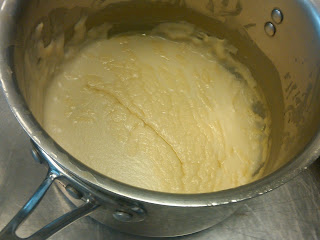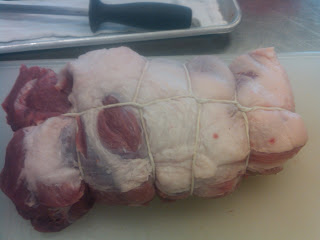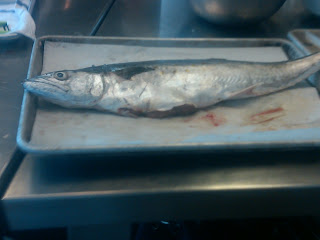Roasted Tomato Coulis-This is a modern day tomato sauce. Instead of cooking sauce in a pot you roast tomatoes, garlic, thyme, and olive oil for around 2 hours in the oven and then use a food mill to mash it up. I think this can be delicious pre-mash as an appetizer or post-mash as a sauce.
 Tomatillo Salsa-SPICY SPICY. There are 2 jalapenos in this salsa but it tasted like one big jalapeno to me, and I like spicy. Chef recommended we wear gloves when working with the jalapenos to avoid getting burns on our hands. To make this easy sauce you blend roasted tomatillos, jalapenos, yellow onion, cilantro, cider vinegar, olive oil, sugar, and salt and pepper. It is really delicious as a dip or a spread to accompany any Mexican dish.
Tomatillo Salsa-SPICY SPICY. There are 2 jalapenos in this salsa but it tasted like one big jalapeno to me, and I like spicy. Chef recommended we wear gloves when working with the jalapenos to avoid getting burns on our hands. To make this easy sauce you blend roasted tomatillos, jalapenos, yellow onion, cilantro, cider vinegar, olive oil, sugar, and salt and pepper. It is really delicious as a dip or a spread to accompany any Mexican dish.Mango Chutney-Favorite of the day. This is an Indian inspired dish that includes cooked mango with a sweet and spicy glaze. The highlighted flavors were the ginger, white wine vinegar and cloves. It reminded me of a Jewish holiday dish so I am going to make it again for Rosh Hashanna. Cousin Derek, you don't need to wait till Thanksgiving after all.
Corn and Red Pepper Relish- This is like a salsa with chopped pepper and corn. By the books a relish is a fruit or veggie combined with vinegar, sugar, and chili. It is a really fresh tasting sauce that can either be eaten with chips or as a side dish.
In addition we learned how to make flavored oils, a citrus juice, and Jus de Veau Lie which is the modern day version of sauce Espangole.






































